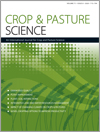Cold plasma is an ionised gas that is an environmentally friendly treatment, leaves no residues and can effectively manage both fungi and insect pests. This review highlights issues with current grain management practices in Australia and demonstrates the ability of cold plasma to treat fungi, mycotoxins and insect pests. We believe this technology has much potential as a new treatment for Australian grain.

Crop and Pasture Science
Volume 71 Number 8 2020
CP20065Influence of seed priming techniques on grain yield and economic returns of bread wheat planted at different spacings
 , Mubshar Hussain, Muhammad Mazhar Habib, Muhammad Shoaib Khan, Imran Ahmad, Shahid Farooq
, Mubshar Hussain, Muhammad Mazhar Habib, Muhammad Shoaib Khan, Imran Ahmad, Shahid Farooq  and Kadambot H. M. Siddique
and Kadambot H. M. Siddique
This study evaluated the effect of different seed-priming techniques on the performance of two bread wheat cultivars (Seher-2006 and Shafaq-2006) planted in rows spaced at 22.5 or 30 cm. Planting osmoprimed seeds of cv. Seher-2006 in 22.5-cm spaced rows could be effectively used to increase productivity and economic returns.
CP18565Methodological aspects and impact on grain weight of source reduction through shade meshes during grain filling of bread wheat
 , Mariana Antonietta, Nicolás Rouillet, Maria G. Cano, Juan J. Guiamet and Eduardo A. Tambussi
, Mariana Antonietta, Nicolás Rouillet, Maria G. Cano, Juan J. Guiamet and Eduardo A. Tambussi
Understanding source–sink relations is important for improving grain yield in wheat. Estimations of reductions in source (i.e. assimilates produced by photosynthesis) on the basis of light attenuation (shading) could be flawed due to methodological biases. In this work we analysed several physiological aspects (e.g. photosynthesis) of source manipulation by meshes.
Improvements in the grain size and weight of barley are appropriate steps for increasing yields. In order to realise these improvements, variation at the gene level needs to be identified and targeted in breeding programs. We identified novel polymorphisms underlying a major gene for grain size and weight that were diagnostic for trait variation; the utilisation of the genetic resources developed through this research will assist in the development of improved barley cultivars.
CP20169 Abstract | CP20169 Full Text | CP20169PDF (584 KB) | CP20169Supplementary Material (262 KB) Open Access Article
Common buckwheat is a valuable crop plant, rich in dietary fibre and rutin, with high protein content and well-balanced amino acid composition. The main problem in buckwheat cultivation is low seed yield due to susceptibility to thermal stress, which results in disturbance to embryological development and high flower and embryo abortion. We found that heat-shock protein HSP-70, which was present in high amounts in buds and open and wilted flowers, could protect them from heat stress.
CP19557Development of SSR markers and association studies of markers with phenology and yield-related traits in grass pea (Lathyrus sativus)
 , Girish Prasad Dixit and Narendra Pratap Singh
, Girish Prasad Dixit and Narendra Pratap Singh
Many cultivated crops are experiencing threats to the changing climatic conditions in recent years. Therefore, identifying genotypes resilient to various climatic conditions and mining of novel genes/alleles related to biotic and abiotic stress tolerance in underutilised crops such as lathyrus will help to breed better varieties in coming years through markers assisted breeding and genomic selection. Here, we report significant marker–trait associations for plant phenology and yield-related traits in grass pea using SSR markers.
CP19301Growth strategies as determinants of CO2 sequestration and response to nitrogen fertilisation in C4 grasses in South American natural grasslands
 , Leandro Bittencourt de Oliveira, Raíssa Schwalbert
, Leandro Bittencourt de Oliveira, Raíssa Schwalbert  , Bianca Knebel Del Frari, Gustavo Brunetto, Fernando Luiz Ferreira de Quadros, Carlos Nabinger and Fernando Teixeira Nicoloso
, Bianca Knebel Del Frari, Gustavo Brunetto, Fernando Luiz Ferreira de Quadros, Carlos Nabinger and Fernando Teixeira Nicoloso
The capacity for CO2 assimilation and response to nitrogen fertilisation by grasses from South American natural grasslands depends on the species present. Grasslands with species of high specific leaf area (SLA) and low leaf dry matter content (LDMC) have higher response potential to nitrogen fertilisation, with increase of 20% in leaf area and also have a potential 13 times higher for CO2 sequestration than grasslands with species with low SLA and high LDMC.
Plant growth is often limited by low water and phosphorus (P) availability in most soils in arid and semi-arid areas. We investigated the effects of soil type, water supply and P supply on plant growth and P and nitrogen nutrition of lucerne. The results showed that soil type and P supply had greater effects than water supply, and provide a scientific basis for pasture development in arid and semi-arid areas.



